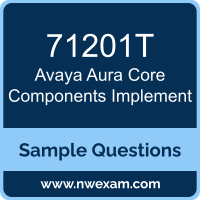01. How does Class of Service (COS) differ from Class of Restriction (COR) in Avaya Communication Manager?
a) COS deals with security settings, whereas COR handles calling permissions.
b) COS manages call quality settings, whereas COR does not.
c) COS pertains to network access, while COR relates to feature access.
d) There is no difference; both terms are interchangeable.
02. Which feature allows you to back up translation data from Avaya Aura® Communication Manager to a safe location?
a) The backup and restore utility in SMI
b) A manual transfer via removable media
c) An automated cloud backup service
d) Emailing the files to a secure email address
03. In testing the Core, how do you verify the functionality of H323 mode on One-X® Softphone?
a) H323 testing is not supported on One-X® Softphones
b) Setting the phone to H323 mode and making a direct call to another H323 device
c) Conducting a routine echo test on the network
d) By initiating a video call test to check bandwidth and quality
04. When applying updates to Avaya Aura® Media Server, what is essential to prevent service disruption?
a) Notify all users about potential aesthetic changes.
b) Conducting updates during peak business hours to capture immediate feedback.
c) Implementing updates in a staged manner to ensure continuous operation.
d) Applying all available updates simultaneously to minimize downtime.
05. What is a key advantage of integrating Avaya Aura® Media Server into an existing network?
a) It eliminates the need for user authentication.
b) It allows for the direct transmission of electrical power over Ethernet.
c) It significantly reduces the need for physical storage.
d) It provides enhanced media processing capabilities.
06. How are SIP trunks configured to Avaya Aura® Communication Manager for OPTIM and call routing purposes?
a) By manually programming each phone
b) Through the web management interface
c) Using an automated script that runs nightly
d) By hiring a specialized consultant
07. During the core integration of Avaya Aura® Session Manager, what is a crucial step?
a) Installing additional security firewalls
b) Assigning static IP addresses to all end devices
c) Configuring SIP entities and their relationships
d) Establishing a physical connection with external servers
08. Why is Avaya Aura® Media Server considered crucial in the platform architecture?
a) It acts as the primary interface for all user interactions.
b) It supports high-definition video conferencing.
c) It solely manages the communications protocols.
d) It provides essential media processing capabilities for real-time communications.
09. What change is anticipated with the deprecation of Avaya Aura® Utility Services in terms of network functionality?
a) Greater integration with Avaya Aura® AADS for essential services
b) None, as there is no impact on network functionalities
c) Transition to cloud-based utility management
d) Increased dependency on external DNS services
10. Who benefits primarily from the integration of Avaya Meetings Server in an organization?
a) Sales teams for better customer interaction
b) All users for unified communications and collaboration
c) Executives for enhanced data security
d) IT administrators for simpler infrastructure management
 Before you write the Avaya Aura Core Components Implement (71201T) certification exam, you may have certain doubts in your mind regarding the pattern of the test, the types of questions asked in it, the difficulty level of the questions and time required to complete the questions. These Avaya Aura Core Components Technical Associate Implement (ASTA-7120) sample questions and demo exam help you in removing these doubts and prepare you to take the test.
Before you write the Avaya Aura Core Components Implement (71201T) certification exam, you may have certain doubts in your mind regarding the pattern of the test, the types of questions asked in it, the difficulty level of the questions and time required to complete the questions. These Avaya Aura Core Components Technical Associate Implement (ASTA-7120) sample questions and demo exam help you in removing these doubts and prepare you to take the test.